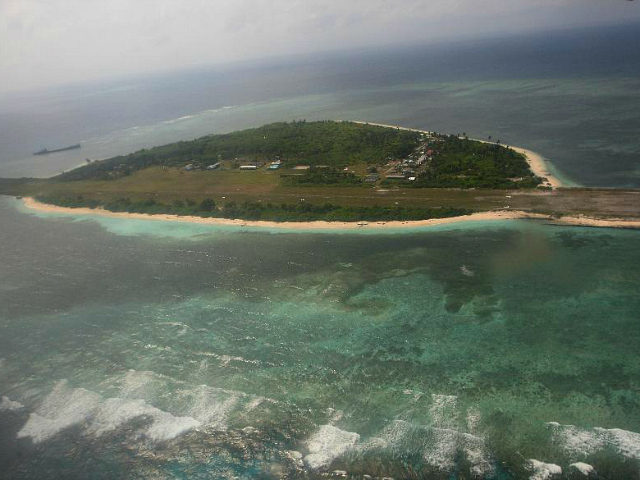On Saturday, two high-ranking Philippine officials visited the island of Pag-asa in the South China Sea, drawing a protest from China, which claims ownership of the entire region.
As the Associated Press observes, the Philippine officials did not visit some uninhabited bit of disputed real estate and plant their national flag; there have been Filipino troops and villagers living on Pag-asa since the late 1970s. It has been open to civilian settlement since 2002. Also known as Thitu Island, it is one of the largest naturally-0ccurring islands in the Spratly Island chain, boasting its own elementary school, medical clinic, and airstrip.
The Philippine government has been considering a sizable investment in the island’s infrastructure to attract more tourists, noting that it offers excellent snorkeling and diving opportunities. A marine research facility may also be constructed there. Additionally, it is believed the island could provide access to offshore oil deposits and other natural resources.
“With its impeccable beauty, the island is an ideal tourist destination… the rich biodiversity and truly Filipino heritage truly reflects the beauty of a paradise that our country should be proud of,” declared Senator Sonny Angara, who has filed a bill for about $30 million U.S. in improvements to Pag-asa.
Chinese protests have made life more difficult for the handful of people living on Pag-asa, most of them soldiers, construction workers, and their families. Among other inconveniences, they have to make do without a proper port facility, even though the island population relies heavily on supplies shipped by the Philippine government. Their supplies are currently transported on launches from ships anchored two kilometers offshore.
Ominous Chinese warnings about violating their South China Sea air defense zone could hamper the air travel that will be required if Pag-asa’s tourism industry is to flourish. Chinese forces challenged both of the planes carrying Filipino VIPs to the island this weekend.
Islanders have grown increasingly nervous about Chinese activity in the South China Sea, which they could no longer ignore once they could see Chinese cranes working to expand nearby islands with their naked eyes.
“We have a good view of the high-rise crane. There are several instances when warships try to run after us or they cross our bow. All of these are affecting the residents. But they’ve been here for a while. They won’t be scared away so easily,” said one islander in a 2015 profile of the tiny community. Other residents grumbled that the Philippine government had abandoned them, possibly motivated by Chinese bribes to key Filipino officials.
Saturday’s visit by Philippine Defense Secretary Delfin Lorenzana and armed forces chief of staff General Eduardo Ano would seem to signal a change in policy. The ostensible purpose of their visit was to inspect the poorly-maintained airstrip (which sprawls over a good twenty percent of the island’s real estate, viewed from the air) and announce the long-awaited construction of a port facility, plus solar power and water desalination facilities.
During the visit, Ano joined soldiers stationed on Pag-asa to sing the Philippine national anthem – which just happens to conclude with a vow to joyfully die fighting oppressors who seek to capture Philippine territory.
“I’m so proud. You know when we were singing the national anthem here in Pag-asa, I don’t know if you feel that it’s a different feeling. It’s very different from the normal flag raising ceremony in the headquarters and doing it here in Pag-asa,” gushed Ano.
The Chinese Foreign Ministry said it was “gravely concerned about and dissatisfied” with the visit by Lorenzana and Ano and has “lodged representations with the Philippine side.” Chinese complaints apparently persuaded Philippines President Rodrigo Duterte to cancel his own plans to visit Pag-asa.
Filipino newspapers erupted with editorials insisting the visit was not unlawful, quoting presidential spokesman Ernesto Abella’s declaration that his government would make “efforts to improve the safety, welfare, and livelihood of Filipinos residing and living in the municipality of Kalayaan, which is part of the province of Palawan.”
Needless to say, the Palawan province is not part of China.
“The Philippines has long been undertaking customary and routine maritime patrol and overflight in the West Philippine Sea which are lawful activities under international law. Such flights will likewise enable us to reach our municipality,” Abella continued.
Lorenzana cited developments by other countries in the South China Sea and told reporters it has “been too long” since the Philippines considered investing in Pag-asa.
“We should have done this even before. Unfortunately, we had a moratorium because we filed a case before the permanent court of arbitration,” he said of plans for renovating the airstrip and building a port facility on the island.
The Manila Bulletin mentions think-tank proposals to thwart Chinese territorial ambitions by building a major international marine research facility on Pag-asa to bolster eco-tourism and then effectively declaring the entire area a gigantic marine park or “no-take zone” preservation area, encompassing nearly a hundred small islands and reefs.
Professor Richard Heydarian, a columnist for the Manila Bulletin, said Defense Secretary Lorenzana’s visit to Pag-asa signaled a “major, major shift” in the Duterte administration’s position on the South China Sea, coming less than a month before scheduled bilateral talks between China and the Philippines.
“I think it’s very important for the Duterte administration to make it clear that improvement of bilateral relations is by no means tantamount to the Philippines just giving up on its claims and relaxing its position on sensitive territorial and maritime issues,” Heydarian said.

COMMENTS
Please let us know if you're having issues with commenting.